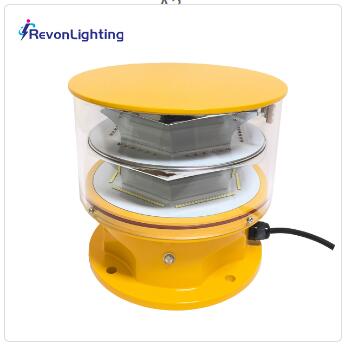Posted: 2024-05-22
Aircraft obstruction lights are essential safety devices that play a crucial role in enhancing aviation safety. These lights are installed on tall structures such as buildings, towers, cranes, or wind turbines to warn pilots of potential obstacles and ensure safe navigation. In this article, we will explore the importance and benefits of aircraft obstruction lights in promoting aviation safety.

Promoting Visibility:
One of the key functions of aircraft obstruction lights is to enhance visibility for pilots, especially during low light conditions or adverse weather. These lights are typically equipped with powerful strobes or LED systems that emit bright and highly visible light. This increased visibility allows pilots to easily identify potential obstacles and make informed decisions to avoid them, thus minimizing the risk of accidents.
| 1 | Aircraft Obstruction Light |
| 2 | 56 |
| 3 | 4. Aircraft Obstruction Light |
Compliance with Aviation Regulations:
Aircraft obstruction lights must adhere to international aviation regulations set by organizations such as the International Civil Aviation Organization (ICAO) and the Federal Aviation Administration (FAA). These regulations specify the type, positioning, and characteristics of obstruction lights to ensure uniformity and consistency across different aviation environments. Compliance with these regulations is essential to maintain aviation safety standards.
Different Types of Aircraft Obstruction Lights:
There are several types of obstruction lights used in aviation, including red lights, white lights, and dual-color lights. Red lights are typically used for structures taller than 150 feet, while white lights are used for structures below that height. Dual-color lights combine red and white lights to provide maximum visibility and are often used on tall structures in close proximity to airports. The choice of obstruction lights depends on the height of the structure and the specific requirements of the aviation environment.
Advanced Technology for Efficiency:
Technological advancements have greatly improved the efficiency and effectiveness of aircraft obstruction lights. LED lights, for example, have become the preferred choice due to their high energy efficiency, long lifespan, and reliability. LED lights consume less energy compared to traditional incandescent lights, resulting in reduced operational costs. Additionally, LEDs have a longer lifespan, reducing the frequency of maintenance and bulb replacements.
Monitoring and Control Systems:
Modern aircraft obstruction lights are often equipped with advanced monitoring and control systems. These systems allow remote monitoring of the lights' status, providing real-time information on their functionality and performance. This enables timely maintenance and repair, ensuring that the lights are always operational. Some systems even offer automated fault detection, sending alerts to maintenance personnel in case of any malfunctions.
Durability and Weather Resistance:
Aircraft obstruction lights are exposed to various environmental conditions, including extreme temperatures, high winds, and heavy rain. Therefore, they need to be durable and weather-resistant. Lights made from robust materials such as corrosion-resistant metals or high-grade plastics can withstand these harsh conditions, ensuring their longevity and reliability.
Importance of Maintenance:
Regular maintenance is crucial to ensure the proper functioning of aircraft obstruction lights. Routine inspections, cleaning, and testing of the lights should be conducted to identify any defects or issues. It is important to have a maintenance schedule in place to ensure that the lights are always in optimal condition and comply with aviation regulations.
Conclusion:
Aircraft obstruction lights are vital safety devices that help prevent accidents and ensure the safe navigation of aircraft. By enhancing visibility, complying with aviation regulations, utilizing advanced technology, and implementing proper maintenance practices, these lights contribute significantly to aviation safety. As the aviation industry continues to prioritize safety, the continuous improvement and implementation of aircraft obstruction lights will play a crucial role in maintaining safe airspace for aircraft worldwide.